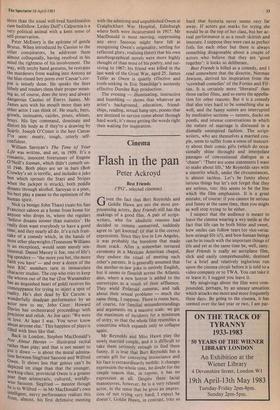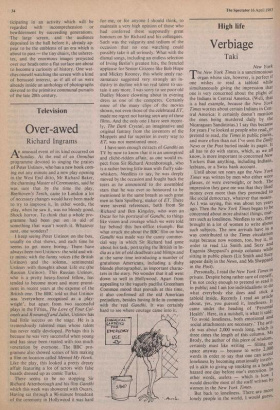Cinema
Flash in the pan
Peter Ackroyd
Best Friends (PG', selected cinemas)
Given the fact that Bert Reynolds and Goldie Hawn are not the most pre- possessing actors, Best Friends still has the makings of a good film. A pair of script- writers, who for idealistic reasons had decided to remain unmarried, suddenly agree to 'get knotted' (if that is the correct expression). Since they live in Los Angeles, it was probably the boredom that made them crack. After a somewhat tortured ceremony in a Mexican American chapel, they endure the ritual of meeting each other's parents. It is generally assumed that the mother-in-law joke is entirely English, but it seems to flourish across the Atlantic also, where a new horror is added to the stereotypes as a result of their affluence. They wield Polaroid cameras, and talk about their sexual problems — much the same thing, I suppose. There is room here, of course, for familial misunderstandings and arguments on a massive scale: we get the maximum of incidents for a minimum of story, so that the whole film resembles a concertina which expands only to collapse again.
Mr Reynolds and Miss Hawn play the newly married couple, and it is difficult to take them seriously enough to find them funny. It is true that Burt Reynolds has a certain gift for conveying insouciance and his face is extraordinarily mobile: it changes expression the whole time, no doubt for the simple reason that, in repose, it has no expression at all. Despite these facial manoeuvres, however, he is a very relaxed actor, in the sense that he gives an impres- sion of not trying very hard; I expect he doesn't. Goldie Hawn, in contrast, tries so
hard that hysteria never seems very far away. If actors got marks for trying she would be at the top of her class, but her ac- tual performance is as a result skittish and insecure. I suppose they were cast as perfect foils for each other but there is always something disagreeable about a couple of actors who believe that they are 'good together': it looks so deliberate.
Best Friends is billed as a comedy, and I read somewhere that the director, Norman Jewison, derived his inspiration from the 'screwball comedies' of the Forties and Fif- ties. It is certainly more 'liberated' than those earlier films, and so earns the appella- tion for other reasons. But it is a comedy that also tries hard to be something else as well, and the funny scenes are interrupted by meditative sections — sunsets, ducks on ponds, and intense conversations in which the nature of marriage is discussed in a dismally uninspired fashion. The script- writers, who are themselves a married cou- ple, seem to suffer from a sense of insecuri- ty about their comic gifts (which do occa- sionally shine through) and interpolate passages of conventional dialogue as a 'chaser': 'There are some statements I want to make about life,' Mr Reynolds says with a sincerity which, under the circumstances, is almost tactless. Let's be funny about serious things but let's not forget that they are serious, too: this seems to be the line which the film emphasises. It is a great mistake, of course: if you cannot be serious and funny at the same time, then you might as well stop trying to be either.
I suspect that the audience is meant to leave the cinema wearing a wry smile at the fact that life can be both bitter and sweet, how smiles can follow tears (or vice-versa: how strange life is!), and how human beings can be in touch with the important things of life and yet at the same time be, well, zany. Best Friends is really an aeroplane film, slick and easily comprehensible, destined for a brief and relatively inglorious run upon the cinema circuit before it is sold to a video company or to TWA. You can take it or leave it; I suggest you leave it.
My misgivings about the film were com- pounded, perhaps, by an uneasy sensation which attacks me more and more frequently these days. By going to the cinema, it has seemed over the last year or two, I am par- ticipating in an activity which will be regarded with incomprehension or bewilderment by succeeding generations. The large screen, and the audience deposited in the hall before it, already ap- pear to be the emblems of an era which is about to pass — the tiny chairs, the usheret- tes, and the enormous images projected over our heads onto a flat surface are about to become a curiosity of history. One wat- ches oneself watching the screen with a kind of bemused interest, as if all of us were already inside an anthology of photographs devoted to the primitive communal pursuits of the late 20th century.











































 Previous page
Previous page